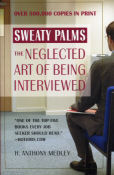| What REALLY goes on in a job interview? Find out in the new revision of "Sweaty Palms: The Neglected Art of Being Interviewed" by Tony Medley, updated for the world of the Internet . Over 500,000 copies in print and the only book on the job interview written by an experienced interviewer, one who has conducted thousands of interviews. This is the truth, not the ivory tower speculations of those who write but have no actual experience. "One of the top five books every job seeker should read," says Hotjobs.com. Click the book to order. Now also available on Kindle. | |
|
The Beatles: Eight Days a Week: The Touring Years (10/10) by Tony Medley Runtime 129 minutes. OK for children. A few years back I was sitting with a group at Joni’s Coffee Roaster in Marina del Rey discussing music and Bruce Springsteen. I asked them to name their five favorite Springsteen songs and hum the melodies for me. Not one could remember the melody of any of his songs, or more than one or two of his titles. I said if somebody asked me the same question about The Beatles, my problem wouldn’t be trying to recall a single melody or title, but would be to choose between the dozens that would instantly flood my mind. Which would I choose out of their more than 160 credited songs which are so familiar, “Yesterday,” “Michelle,” “Here, There, and Everywhere” (maybe my favorite), “Eleanor Rigby,” “Ob-La-Di, Ob-La-Da,” “Julia” (John Lennon’s paean to his mother), “Norwegian Wood,” “When I’m Sixty-Four” (written by Paul McCartney when he was 16); well, you get my point. Director Ron Howard said that one of the main reasons he was drawn to this project was to introduce The Beatles phenomenon to new generations. While he achieved that, he also showed to those of us who lived through it why they stopped touring, and what an ordeal it became. Since Howard was born March 1, 1954, he would have only been 10 years old when Ed Sullivan introduced The Beatles to America on his TV show, and he would have been 16 years old when they broke up six years later in 1970. So he would have been at a very impressionable age during The Beatles’ prime years. His film is an amalgamation of wonderful archival concert films of performances of mostly entire songs and candid interviews with not only the four Beatles, John Lennon, Paul McCartney, Ringo Starr, and George Harrison, but also people like Whoopi Goldberg, Richard Lester (director of The Beatles’ two feature films, Hard Days’ Night and Help!), Eddie Izzard, and many more about their experiences working with the Beatles, being fans, and being influenced by them. Many things come across in this captivating film, not the least of which is how it paints the ordeal that touring became. The noise of the crowd was so loud throughout their concerts that even The Beatles themselves could sometimes not hear the music they were playing. The crowds were so passionate that the artists sometimes felt that their well-being was in danger, and this is well captured in the archival films. Another thing is how amazingly prolific they were. Touring would be enough for anybody, but they also kept producing a prodigious amount of original music, as well as performing in two movies. I hate to admit this, because I am a proud Beatlemaniac. I have several complete music books of all the Beatles songs, which I play on the piano. I have not, however, played all of the songs. One I have never played is “Baby’s in Black” from the 1964 album “Beatles for Sale.” It’s a charming waltz and hearing it for the first time during this screening was as exciting as listening to “Sgt. Pepper’s Lonely Hearts Club Band” or “Abbey Road” for the first time. I could go on and on about The Beatles’ music and this movie, but I won’t. This is one of the most enjoyable movies of the year. When the PR rep who sent me the screening invite told me it was 129 minutes long, I responded that normally I’m disappointed when I learn a film is more than 90 minutes in runtime, but in this case I’m disappointed it’s only 129 minutes long, and that’s the way I felt when the film ended. It ends, incidentally, with the entire Shea Stadium concert, which I had never heard. It’s been remixed so that the music is clearly audible despite the deafening crowd noise. Watching this concert is well worth the price of admission by itself, but the rest of the movie is just as good.
|
|
|
|
|
